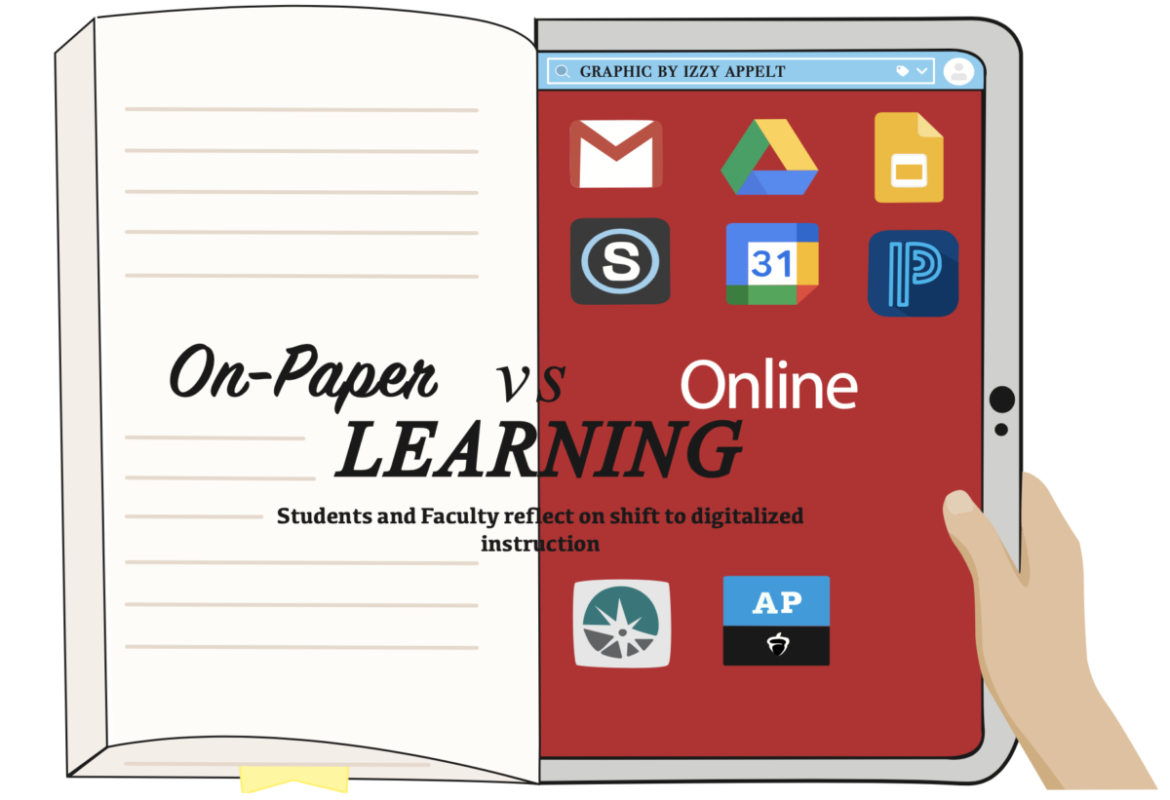Izzy Appelt, Editor in Chief
@Izzyacourant
The traditional classroom image that once was defined by the scratching of pencil on paper and murmurs of student chatter has been replaced by the clicking of keyboards and glowing faces encapsulated by the promise of limitless knowledge. As technology continues to revolutionize the way we live and work, especially following the COVID-19 pandemic, the age-old debate of online versus on-paper learning has taken center stage in the realm of education.
As schools reopened, teachers increasingly implemented new digital tools used during the pandemic to supplement in-school learning, changing the level of student retention. “When we went digital, we vastly overestimated how much students can learn through digital processes, like assuming that kids can and will effectively annotate a digital document or take notes as opposed to by hand,” English teacher Matthew Quinn said. “From the reading I’ve done, I have learned there is something important that happens in how you encode information in your brain when you have a particular movement with the hand that creates words.”
Sophomore Julia McPhillips also expressed her belief in the power of traditional note taking methods for productive studying. “I prefer to study on paper because writing things down helps you remember stuff more effectively, however for some work, like writing essays for English, using a computer is much more efficient.” she said.
Junior AP Lang student Sloane Griffiths delved deeper into this topic through an English project in which she wrote an opinionated letter to Principal Bill Egan on the use of technology in the classroom using research gathered through peers and staff members. “I chose to do this piece because during hybrid learning, we became really dependent on technology and the use of it was incredibly beneficial at that time as it allowed us to learn during a tough time,” she said. “Now that things are kind of back to normal and we’re doing full in-person learning, continuing to integrate more and more technology into school is unnecessary and actually harmful for students.”
Specifically in her research, Sloane found that certain subjects are more affected by increased digital use than others. “In certain classes, the use of technology can be incredibly beneficial, such as for research, writing assignments, and doing more creative work,” she said. “But when it comes to world language, students won’t be learning vocab and grammar concepts with the answers right in front of them. I also find when it comes to science and math, it wastes time trying to do any of that work online as it’s really difficult to bring a hands-on process to the screen,” she said.
The increasing reliance on the internet has also posed a problem for teachers in maintaining a cheat-free classroom. “In terms of academic integrity, the internet erodes students of intellectual bravery because they want confirmation that what they’re going to say is right,” Mr Quinn said. “In the last year or two, students have not come to terms with the fact that all of these attempts to find out what’s really going on is skipping over the most important part of education.”

Another problem that has risen is the temptation of students to become sidetracked by their laptops during class time. “There are too many temptations for students to get off track when they’re using digital media. There’s always this question I think you have to ask whenever you’re thinking about technology: Will this be an effective teaching tool for most students, given what we know about students?” Mr Quinn said. “The biggest problem is that it’s so easy to get stuck down the rabbit hole online.”
Nevertheless, the digital world has opened a number of opportunities for students, especially in working with peers from outside the classroom. “I think that one of the things that it’s definitely done is give students the ability to collaborate when they’re not near each other, which going back to the dark old days when I was in high school, that just wasn’t possible,” Mr Quinn said.
As digital learning has become increasingly prevalent at school, it is crucial to maintain a steady mix between teaching methods in order to foster a well rounded education and cater to students’ diverse learning styles. “It’s really important to find a balance between using paper and technology. The benefits of technology make it clear it should be kept in the classroom but we can work to limit its usage so students spend less time in front of screens and receive the best educational experience they can,” Sloane said.




